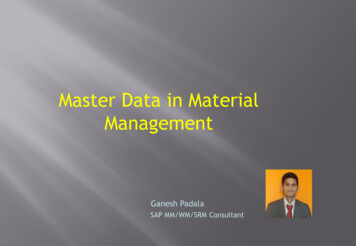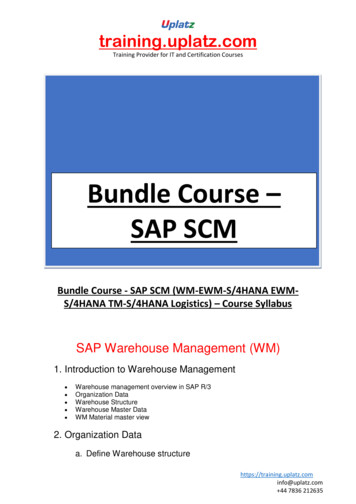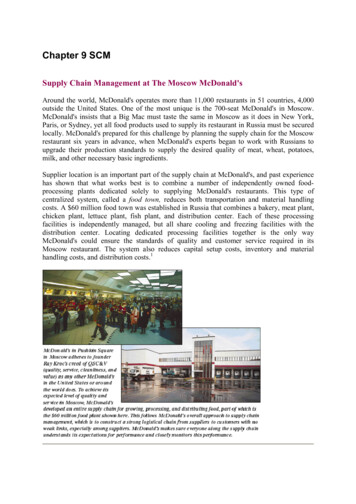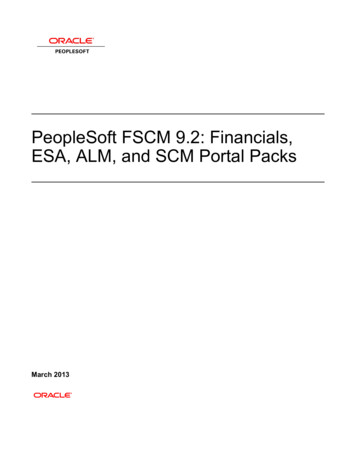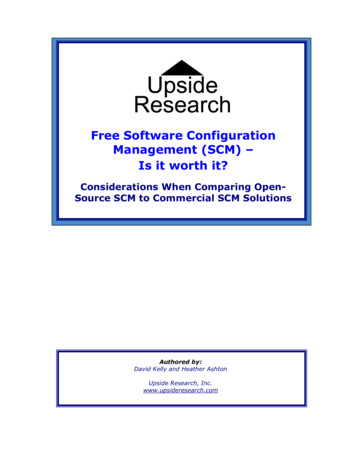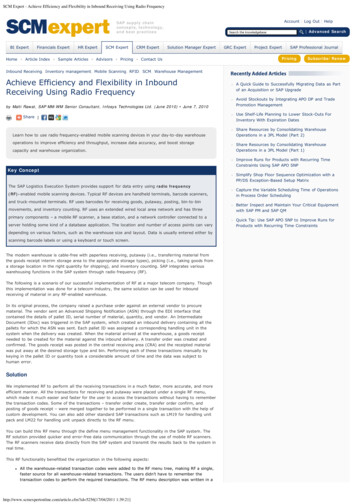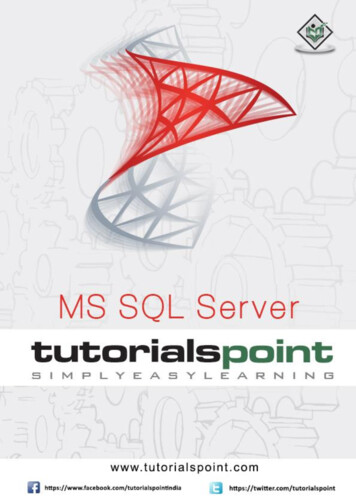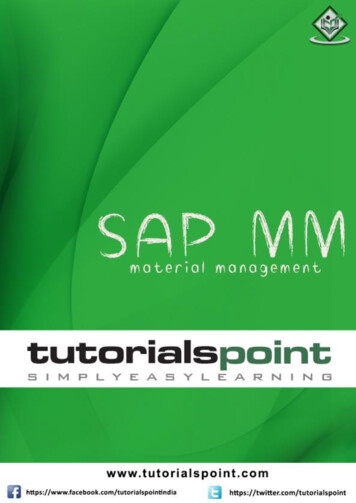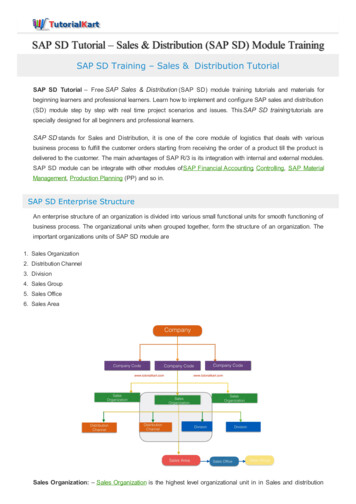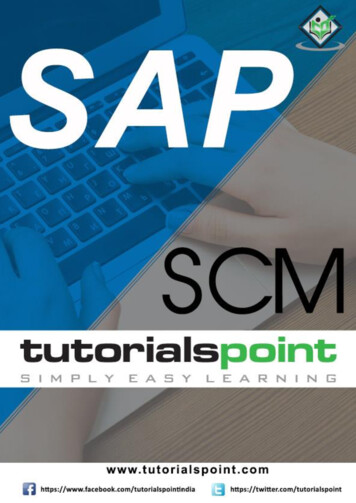
Transcription
SAP SCMAbout the TutorialSAP Supply Chain Management is one of the key modules in SAP ERP and controlsProduction Planning, business forecasting and demand planning. It helps the organizationto manage their supply chain process in a dynamic environment. SAP SCM is a completesoftware to cover key processes such as supply chain networking, supply chain planningand coordination, and supply chain execution.AudienceThis tutorial is meant for Project leaders, project team members, SAP consultants, salesconsultant, and those related to the departments of planning and material management.PrerequisitesBefore you start proceeding with this tutorial, we are assuming you have familiarity, priorexperience, and knowledge of the domain of supply chain management. However, it issufficient if you are aware of the basics of computer applications and SAP tools.Copyright & Disclaimer Copyright 2018 by Tutorials Point (I) Pvt. Ltd.All the content and graphics published in this e-book are the property of Tutorials Point (I)Pvt. Ltd. The user of this e-book is prohibited to reuse, retain, copy, distribute, orrepublish any contents or a part of contents of this e-book in any manner without writtenconsent of the publisher.We strive to update the contents of our website and tutorials as timely and as precisely aspossible, however, the contents may contain inaccuracies or errors. Tutorials Point (I) Pvt.Ltd. provides no guarantee regarding the accuracy, timeliness or completeness of ourwebsite or its contents including this tutorial. If you discover any errors on our website orin this tutorial, please notify us at contact@tutorialspoint.comi
SAP SCMTable of ContentsAbout the Tutorial . iAudience . iPrerequisites . iCopyright & Disclaimer . iTable of Contents . ii1.SAP SCM – Overview . 12.SAP SCM – Components . 23.SAP SCM – Benefits . 44.SAP SCM – Demand Management . 5Planning Strategies . 55.SAP SCM – Creating PIR. 7Change and Delete PIR . 86.SAP SCM – Material Requirement Planning . 10MRP Parameters . 10Running MRP for all Products . 11MRP Evaluation – Stock / Requirement List . 15SAP PP – MRP List . 167.SAP SCM – Planned Order Creation . 178.SAP SCM – Production Order Creation . 229.SAP SCM – Goods Issue . 25Goods Issue Reversal . 2610. SAP SCM – Production Order Confirmation . 2811. SAP SCM – Production Order Cancellation . 3012. SAP SCM – Integration . 3113. SAP SCM – Integration Models . 32Activation and Deactivation of Integration Model . 3414. SAP SCM – Master Data . 37Bills of Material (BOM) . 37Material Master . 38Work Center . 39Routing . 4015. SAP SCM – Resources . 42Resource Types . 42Create and Change Resources . 43ii
SAP SCM16. SAP SCM – Production Data Structures . 44Production Data Structure in SAP APO . 45Production Data Structure in ERP . 4617. SAP SCM – Transfer Changed Master Data . 4918. SAP SCM – Transfer Changed BOMs . 5119. SAP SCM – Model and Versions . 53Creating Model . 54Delete Model/Planning Version . 5720. SAP SCM – Applications . 6021. SAP SCM – Advanced Planning and Optimization APO . 61Supply Chain Monitoring . 6122. SAP SCM – Extended Warehouse . 63Communication Method . 63SAP EWM – Menu Structure . 6423. SAP SCM – Transportation Management . 67Custom Settings in APO . 6924. SAP SCM – Supply Network Collaboration . 7125. SAP SCM – Forecasting & Replenishment . 73SAP F&R Administration . 7326. SAP SCM – Consultant Responsibilities . 75iii
1. SAP SCM – OverviewSAP SCMSAP Supply Chain Management is one of the key modules in SAP ERP and controlsProduction Planning, business forecasting and demand planning.The key features of SAP SCM are It helps the organization to manage their supply chain process in a dynamicenvironment. SAP SCM process helps suppliers, customers, manufacturers, business partners andretailers connect with each other to manage supply chain process effectively andefficiently. It helps organizations to accelerate and optimize end-to-end procure-to-payprocess. SCM products from SAP allows an organization to integrate their processes andenforce contract compliance for supply-side and supplier-side requirementsthroughout using supply chain processes in distributed environment. SAP SCM is a complete software to cover the key processes- Supply Chainnetworking, supply chain planning and coordination, and supply chain execution. It includes different planning applications related to Advanced Planning andOptimization APO, and for the integration with other SAP execution applications. The primary applications are SAP General Areas, SAP Supply Network CollaborationSNC, SAP Extended Warehouse Management EWM, Advanced Planning andOptimization (APO), Forecasting and Replenishment FRE and SAP TransportationManagement TM.In the image shown below, you can see SAP Supply Chain Management and its integrationwith other R/3 modules to manage supply chain process.1
2. SAP SCM – ComponentsSAP SCMSAP Supply Chain Management allows organizations to perform effective planning andexecution of logistics within supply network and to perform workflow management.You can see the key steps in managing Supply network in an organization. Each stepconsists of defined set of activities and hence helping customers, suppliers, and retailersconnect with each other to provide an effective supply-chain-management solution.SAP SCM consists of the following components SC Collaboration: This is used to help in making collaborative forecasts andagreements. SC Planning: This is used to generate the operational plans as per current andrelevant data in the system. SC coordination: This component in Supply Chain is used to coordinate theexchange of data and information between different business units. SC Execution: This is used to ensure that you execute the supply chain plans inthe best possible manner to get the desired result.As per functionality, you can divide SCM/APO into three parts Forecasting: To perform demand planning and forecasting, you can link toCustomer Relationship Management CRM to get data related to customercampaigns, etc. Supply Network Planning (SNP): To view organization as a network of locationsand to check stock projections and stock keeping criteria. Calculations in SNP drivedependent requirements down to supplying locations production and receivingstores. Production Planning and Detailed Scheduling: This is to check the dependentrequirements from locations within the supply network, passed down from SNP.2
SAP SCMThis is linked with Material Requirement Planning (MRP) in Production Planning, whichdetermines the inbound material required to complete a production order.3
3. SAP SCM – BenefitsSAP SCMUsing Supply Chain Management in SAP, an organization can achieve the following benefitsin a distributed environment Reduce accounts receivable collections with better visibility into the AR process,aging, and extension of credit and consequently, help to reduce the day’s salesoutstanding. Effectively manage forecasting and handling sudden changes in demand and supplyprocess. Effectively use Net Fixed assets NFA like plants and equipment. To meet customer demands, you can smartly plan and manage Supply ChainManagement process in an organization. Proper inventory optimization, order fulfillment, and shipping of the goods. Distribution of the key information to all the stakeholders spread across thenetwork. Improve communication and collaboration between different business lines tomanage demand and supply process in an organization. Improve production efficiency and reduction in production quality issues and hencereduce cost of goods s
SAP SCM – Overview . SAP SCM 2 SAP Supply Chain Management allows organizations to perform effective planning and execution of logistics within supply network and to perform workflow management. You can see the key steps in managing Supply network in an organization. Each step consists of defined set of activities and hence helping customers, suppliers, and retailers connect with each other .
